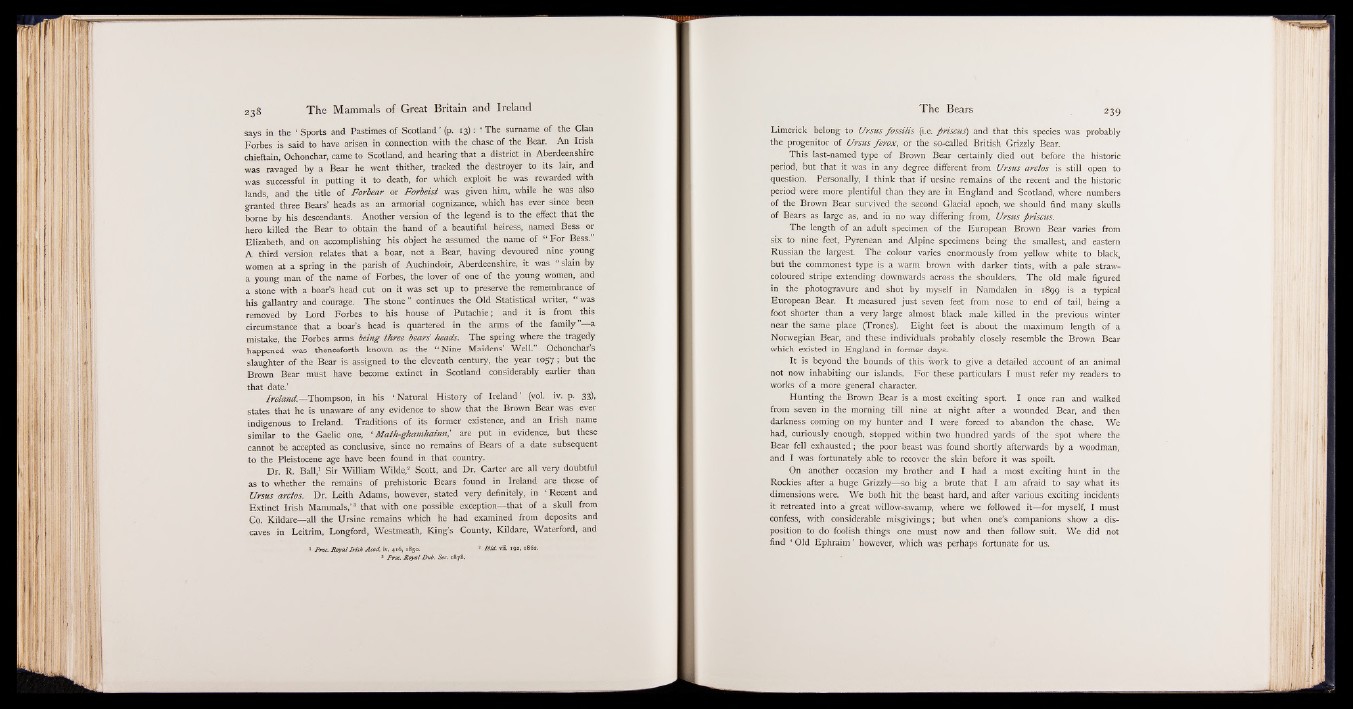
says in the ‘ Sports and Pastimes of Scotland’ (p. 13): 'The surname of the Clan
Forbes is said to have arisen in connection with the chase of the Bear. An Irish
chieftain, Ochonchar, came to Scotland, and hearing that a district in Aberdeenshire
was ravaged by a Bear he went thither, tracked the destroyer to its lair, and
was successful in putting it to death, for which exploit he was rewarded with
lands, and the title of Forbear or Forbeist was given him, while he was also
granted three Bears’ heads as an armorial cognizance, which has ever’ since been
borne by his descendants. Another version of the legend -is to the effect that the
hero killed the Bear to obtain the hand of a beautiful heiress, named Bess or
Elizabeth, and on accomplishing his object he assumed the name of “ For Bess."
A third version relates that a boar, not a Bear, having devoured nine young
women at a spring in the parish of Auchindoir, Aberdeenshire, it was “ slain by
a young man of the name of Forbes, the lover of one of the young women, and
a stone with a boar’s head cut on it was set up to preserve the remembrance of
his gallantry and courage. The stone ” continues the Old Statistical writer, “ was
removed by Lord Forbes to his house of Putachie; and it is from this
circumstance that a boar’s head is quartered in the arms of the family
mistake, the Forbes arms being three bears' heads. The spring where the tragedy
happened was thenceforth known as the “ Nine Maidens’ Well.j||Ochonchar’s
slaughter of the Bear is assigned to the eleventh century,, the year 1057 ; but the
Brown Bear must have become extinct in Scotland- .considerably earlier than
that date.’
Ireland.— Thompson, in his ‘ Natural History of Ireland’ (vol. iv. p. 33),
states that he is unaware of any evidence to show that the Brown Bear was ever
indigenous to Ireland. Traditions of its former existence, and an Irish name
similar to the Gaelic one, ‘ Math-ghamhainn! are put in evidence, but these
cannot be accepted as conclusive, since no remains of Bears1 of a date subsequent
to the Pleistocene age have been found in that/country.
Dr. R. Ball,1 Sir William Wilde,1 Scott, and Dr. Carter are all very doubtful
as to whether the remains of prehistoric Bears found in Ireland are those of
UrsHS arctos. Dr. Leith Adams, however, stated very definitely, in ‘ Recent and
Extinct Irish Mammals,’8 that with one possible exception— that of a skull from
Co. Kildare— all the Ursine remains which he had examined from deposits and
caves in Leitrim, Longford, Westmeath, King's County, Kildare, Waterford, and
1 Proc. Royal Irish Acad. iv. 416,1850.
3 Proc. Royal Dub. Soc. 1878.
3 Ibid. viL 192, 1862.
Limerick belong to Ursus fo ssilis (i.e. priscus) and that this species was probably
the progenitor of Ursus ferox, or the so-called British Grizzly Bear.
This last-named type of Brown Bear certainly died out before the historic
period, but that it was in any degree different from Ursus arctos is still open to
question. Personally, I think that if ursine remains of the recent and the historic
period were more plentiful than they are in England and Scotland, where numbers
of the Brown Bear survived the second Glacial epoch, we should find many skulls
of Bears as large as, and in no way differing from, Ursus priscus.
The length of an adult specimen of the European Brown Bear varies from
six to nine feet, Pyrenean and Alpine specimens being the smallest, and eastern
Russian the largest. The colour varies enormously from yellow white to black,
but the commonest type is a warm brown with darker tints, with a pale straw-
coloured stripe extending downwards across the shoulders. The old male figured
in the photogravure and shot by myself in Namdalen in 1899 is a typical
European Bear. It measured just seven feet from nose to end of tail, being a
foot shorter than a very large almost black male killed in the previous winter
near the same place (Trones). Eight feet is about the maximum length of a
Norwegian Bear, and these individuals probably closely resemble the Brown Bear
which existed in England in former days.
It is beyond the bounds of this work to give a detailed account of an animal
not now inhabiting our islands. For these particulars I must refer my readers to
works of a more general character.
Hunting the Brown Bear is a most exciting sport. I once ran and walked
from seven in the morning till nine at night after a wounded Bear, and then
darkness coming on my hunter and I were forced to abandon the chase. We
had, curiously enough, stopped within two hundred yards of the spot where the
Bear fell exhausted; the poor beast was found shortly afterwards by a woodman,
and I was fortunately able to recover the skin before it was spoilt.
On another occasion my brother and I had a most exciting hunt in the
Rockies after a huge Grizzly— so big a brute that I am afraid to say what its
dimensions were. We both hit the beast hard, and after various exciting incidents
it retreated into a great willow-swamp, where we followed it— for myself, I must
confess, with considerable misgivings; but when one’s companions show a disposition
to do foolish things one must now and then follow suit. We did not
find ‘ Old Ephraim ’ however, which was perhaps fortunate for us.